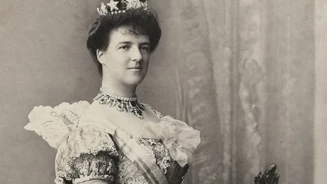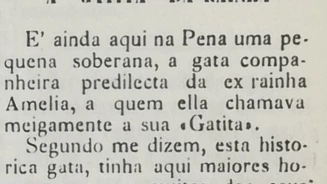The Queen's Cat. How the fall of the monarchy separated Queen Amelia from her four-legged best friend
05 Aug 2024
Sintra's monuments are part of Portugal's history, but it's the 'little' stories that bring them to life. Today we are going to learn about the 'Queen's Cat.'
We don't know if this was the name she was given at birth, but 'Gatita’ (Little Cat) is what Queen Amelia called her. According to a chronicle written by Augusto Barreto, the first steward of the Palace of Pena, appearing in the newspaper O Concelho de Cintra in 1911 – after the fall of the monarchy – the queen liked to spoil her cat: the cat had a silver collar with the name 'Amelia' engraved on it; she enjoyed snacks of the highest quality, such as ‘the delicious prawns from Barra and fine British gateau,’ and, of course, was cuddled every day by her owner.
Queen Amelia was the last sovereign to inhabit the Palace of Pena, which is where she was on the morning of 5 October 1910, the day the Republic was established and from where she left for exile. Gatita ended up staying behind in the huge palace, hoping always to see her owner again. Augusto Barreto, who lived in the Palace of Pena after the fall of the monarchy, wrote: ‘Every day I find her inside the palace. She wanders around as if still looking for her previous royal master. All coquettish and sleek, she is still the absolute mistress of the most luxurious rooms in the castle. She spends the best of her life in the Queen's chambers, preferring them to all the others.’

After her owner's departure, Gatita continued to be fed by former employees of the Royal Family and lived quietly in the Palace. When visitors came to the Palace, Gatita was the centre of attention. Some visitors even attempted to adopt the cat: in another article written for the same newspaper in November of that year, Augusto Barreto tells the bizarre story of a French lady who wanted at all costs to take the kitten to Toulouse when she was in Sintra to take part in an International Tourism Congress. ‘She asked me if she could take her to that city in the south of France. I kindly told her no, which she didn't forgive me for. She asked me the same thing several times in a very cruel way while she was in Pena,’ he recalled. Unable to keep the animal, the lady decided to take another souvenir: ‘At the Lisbon City Council ball in honour of tourists, when I was in one of the halls, a lady in a white gala dress came up to me rather unexpectedly, asking me in pure French for the cat. I immediately recognised the French lady from Toulouse. I told her the cat was fine and, after several conversations, I asked her for a waltz. When I said goodbye and thanked her, she said to me with French grace: “You didn't want to give me the beautiful cat, but I've got a nice souvenir from her.” And with a laugh she disappeared,’ describes Augusto Barreto, who later discovered that Gatita's silver collar had gone missing.

With or without a collar, the little cat continued to be the owner and mistress of her palace, always hoping to see her master again: ‘The few times she goes outside, she always looks for the highest points to look to the horizon. When I see her gazing at the sea, I remember, and I believe, that she is the only friend her owner left here, and that of all the people who flattered and served her, none remembers Queen Amelia more than her cat. Who knows whether in her lynx's eye view, gazing at the sea, she feels the longing of such an abrupt separation more than anyone else. And that's why the regal cat is still waiting for her owner, so she can once again savour the fine prawns of Barra and the sweet biscuits of the City.’
